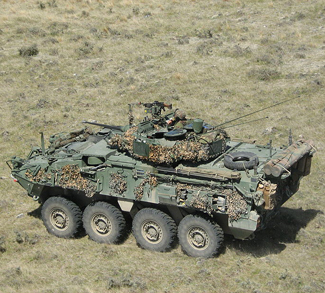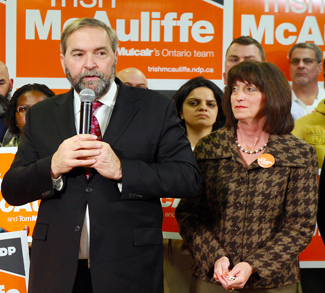Canada has long been known for being a disarmament champion. 2016 marked the 20th anniversary of the beginning of the “Ottawa Process,” which eventually led to the Landmine Convention (Convention on the Prohibition of the Use, Stockpiling, Production, and Transfer of Anti-Personnel Mines, including their destruction). Canada has also played a crucial role as a conflict mediator, has been a global peace broker for decades, and engaged in a wide range of humanitarian aid efforts. However, Canada has, despite its many initiatives and endeavors, strayed far from the “road to disarmament” over the previous decade.
For years, the Canadian government has made billions of dollars on the sale of advanced weapons to countries, many of which boast less than pristine human rights records. Outlined within the “Report on Exports of Military Goods from Canada,” nearly $30 million CAD was the export value associated with arms sold to Algeria, over $10 million CAD to Egypt, $2 million to Iraq, $5 million CAD to Jordan, nearly $2 million CAD to Nigeria, $6 million CAD to Thailand, and close to $100 million CAD to Saudi Arabia – a country having earned the lowest ranking on human rights by Freedom House and Amnesty International, among other watchdogs.
Over the past 12 months, Canada has vaulted to a shining 6th place among the world’s top arms sellers and has recently claimed its place as the No. 2 arms dealer to the Middle East. It is a cardinal moment for Ottawa, which has never held the position. Today, only 5 countries sell more weapons around the world. Increased activity in Canadian arms sales converges with Canada’s decision not to sign an international treaty designed to regulate the global arms trade.
Canada’s military exports demonstrate that Ottawa is almost certainly looking for the biggest buyers of weapons and technology.
The United Nations (UN) Arms Trade Treaty (ATT) came into force on December 24, 2014 but Ottawa has opted-out and instead joined the club of non-signatories: Russia, China, Syria, and North Korea. The United Kingdom (UK), Germany, France, and Spain signed without hesitation, and even the United States (US) signed the treaty though has yet to ratify it. The Canadian government’s official position was that its internal control mechanisms were strong enough to manage the export of its military items.
Criticism against Canada’s business ventures with governments looking to arm themselves against internal and external threats to national security position their case on the issue of human rights and abuses that have led to the deaths of many innocent people. The case has been made that the sale of arms is simply good business, good for the Canadian economy, and good for the global economic pulse. However, such an argument is too one-sided, and fails to put into perspective the consequences of selling arms to countries with such spotty human right records.
The Canadian defense sector is comprised predominantly of companies dealing in electronics and firms focusing on the production of sub-systems that eventually become part of a final product. Communications and radar equipment, sensory equipment and electronics used for navigation, other computer systems and software, and various defense systems comprise this sector. Light armed vehicles (LAVs) and an assortment of munitions are also largely produced as part of Canada’s defense sector.
Over a decade ago, the Canadian aerospace industry contributed some 80,000+ civilian jobs to the Canadian economy. Today, the aerospace industry provides more than $28 billion to Canada’s GDP and contributes some 211,000 jobs. 70% of the industry’s activity focuses on manufacturing. 2015 Defense industry statistics have been published and made available through the Aerospace Industries Association of Canada (AIAC). There is little doubt that Canadians have profited from the production of weaponized machines and components even if they are not entirely aware of where they are going.
Whereas the Ottawa Convention once showed Canada’s determination to achieve disarmament and that cooperative efforts toward that goal are indeed possible, Canada’s role in the global arms trade today exemplifies that the opposite holds true, which is all the more contradictory given Prime Minister Justin Trudeau’s humanitarian and diplomatic rhetoric. Indeed, Canada occupies a unique global position, demonstrating that even countries determined to build peace cannot abandon the claim that conflict and war fuel the economy, provide for millions of Canadians, and that doing so under the guise of responsible conviction is feasible.
Canada has faced budgetary pressures just as the US has, and in keeping necessary production going, Canada has turned to buyers categorized by Ottawa’s defense relationships. Outside of the US, the UK was the largest export destination in 2015 ($100 million CAD of military exports). Saudi Arabia held second place for Canadian military exports in 2015 with total sales to Riyadh accounting for 14% of Canada’s military exports.
Thailand accounted for a sizeable purchase of Canadian arms and components. However, in 2016, Canadian Foreign Affairs Minister, Stéphane Dion prevented the sale of arms to Thailand in favor of a $15 billion CAD export of military vehicles arranged under the Stephen Harper administration to Saudi Arabia – a country scoring lower on its overall freedom rating than Thailand. Canada’s LAVs are being sold to the Saudi Arabian National Guard, which is tasked with protecting against internal threats and could be used against the country’s Shia Muslim minority.
General Dynamics Land Systems Canada (GDLS-C) retains a 15-year contract to produce military vehicles for Saudi Arabia and is still collecting the necessary materials to begin production. The deal is expected to create 3,000 Canadian jobs.
Thailand is currently not engaged in military action with any other country, however, internal security tensions are on the rise, and it still has a longstanding insurgency in its southern provinces, meaning there is demand among the government for military hardware from Canada. The same kind of hardware Canada has provided to Saudi Arabia. Saudi Arabia has seen its need for new military hardware increase rapidly over the past few years. As a result of its military engagements in Yemen – labeled part of the Sunni-Muslim Kingdom’s Cold War in the Middle East – it has been incurring military losses, meaning it only stands to reason that lost military equipment needs to be replaced. Canada is in the midst of entrenching itself in a position of providing those states with the requisite weaponry to replace such losses and maintain their military postures.
Under the export control policy guidelines that were put in place in 1986, many of Canada’s sales contradict Ottawa’s institutional position on the export of military good and technologies. For instance, Canada claims to control its exports to countries that pose a threat to Canada and its allies, that are either part of or that can easily become part of hostilities, and to countries with governments associated with persistent records of egregious action and violations of the human rights of the people they are tasked with protecting. Adding to the existing controversy is the assessment process undertaken by Ottawa in its lead-up to signing export permits. This process lacks transparency and it is difficult to decipher just how Ottawa follows through on its risk analyses.
Canada’s military exports demonstrate that Ottawa is almost certainly looking for the biggest buyers of weapons and technology. Countries around the world are increasingly showing interest in acquiring advanced weapons component and technologies, and military platforms from Western countries. Canadian-made weapons now fuel the hybrid war ongoing in eastern Ukraine – a war in which both the regular and irregular armed forces on the both the Russian and Ukrainian sides have violated the laws of war. The 2004 sale of Bell 4I2 Helicopters to Pakistan brought home about $346 million CAD with a further $22 million CAD from the sale of aircraft machinery to Indonesia. Canada also sold millions of dollars worth of “Twin Pac” helicopter engines to Indonesia during the Cold War.
Ottawa has no control over the use of goods and technologies after they have been exported, unearthing the paradoxical side of Canada’s positions on disarmament that while states may be big buyers of Canadians arms and arms components, states can also act as important conduits for doing business with violent non-state actors (VSNAs). Arms acquisition by states in volatile regions will likely have an impact but it is difficult to say where exactly that impact will be. Effects can be seen externally and internally but one might expect to see a greater impact on the domestic side of the ledger. Enhanced arms sales are not being considered in a much broader and more strategic context of intra-state, inter-state, and regional/global security.
Much like the US, Canada is increasingly paying attention to the economic potential of becoming involved in proxy wars. In many conflicts around the world, it has become an unsettling truth that military power is the only way to reach a solution. Given that many countries do not have the necessary military industry to support their wars against other states and armed groups, they are able to turn to countries like Canada for their military equipment.
The opinions, beliefs, and viewpoints expressed by the authors are theirs alone and don’t reflect any official position of Geopoliticalmonitor.com.




